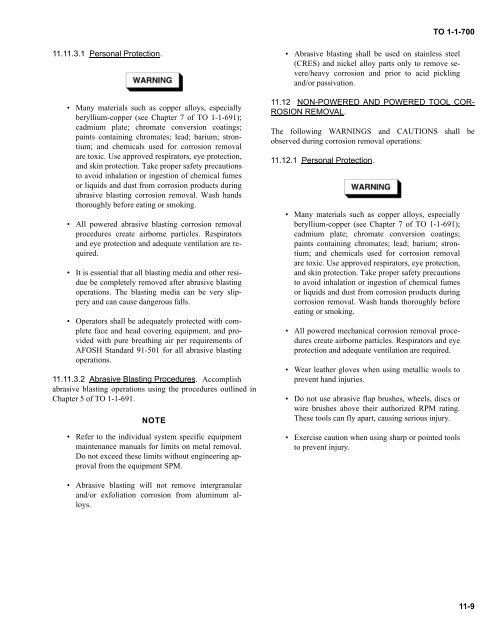TO 1-1-700 - Robins Air Force Base
TO 1-1-700 - Robins Air Force Base
TO 1-1-700 - Robins Air Force Base
You also want an ePaper? Increase the reach of your titles
YUMPU automatically turns print PDFs into web optimized ePapers that Google loves.
<strong>TO</strong> 1-1-<strong>700</strong><br />
11.11.3.1 Personal Protection.<br />
• Many materials such as copper alloys, especially<br />
beryllium-copper (see Chapter 7 of <strong>TO</strong> 1-1-691);<br />
cadmium plate; chromate conversion coatings;<br />
paints containing chromates; lead; barium; strontium;<br />
and chemicals used for corrosion removal<br />
are toxic. Use approved respirators, eye protection,<br />
and skin protection. Take proper safety precautions<br />
to avoid inhalation or ingestion of chemical fumes<br />
or liquids and dust from corrosion products during<br />
abrasive blasting corrosion removal. Wash hands<br />
thoroughly before eating or smoking.<br />
• All powered abrasive blasting corrosion removal<br />
procedures create airborne particles. Respirators<br />
and eye protection and adequate ventilation are required.<br />
• It is essential that all blasting media and other residue<br />
be completely removed after abrasive blasting<br />
operations. The blasting media can be very slippery<br />
and can cause dangerous falls.<br />
• Operators shall be adequately protected with complete<br />
face and head covering equipment, and provided<br />
with pure breathing air per requirements of<br />
AFOSH Standard 91-501 for all abrasive blasting<br />
operations.<br />
11.11.3.2 Abrasive Blasting Procedures. Accomplish<br />
abrasive blasting operations using the procedures outlined in<br />
Chapter 5 of <strong>TO</strong> 1-1-691.<br />
NOTE<br />
• Refer to the individual system specific equipment<br />
maintenance manuals for limits on metal removal.<br />
Do not exceed these limits without engineering approval<br />
from the equipment SPM.<br />
• Abrasive blasting shall be used on stainless steel<br />
(CRES) and nickel alloy parts only to remove severe/heavy<br />
corrosion and prior to acid pickling<br />
and/or passivation.<br />
11.12 NON-POWERED AND POWERED <strong>TO</strong>OL COR-<br />
ROSION REMOVAL.<br />
The following WARNINGS and CAUTIONS shall be<br />
observed during corrosion removal operations:<br />
11.12.1 Personal Protection.<br />
• Many materials such as copper alloys, especially<br />
beryllium-copper (see Chapter 7 of <strong>TO</strong> 1-1-691);<br />
cadmium plate; chromate conversion coatings;<br />
paints containing chromates; lead; barium; strontium;<br />
and chemicals used for corrosion removal<br />
are toxic. Use approved respirators, eye protection,<br />
and skin protection. Take proper safety precautions<br />
to avoid inhalation or ingestion of chemical fumes<br />
or liquids and dust from corrosion products during<br />
corrosion removal. Wash hands thoroughly before<br />
eating or smoking.<br />
• All powered mechanical corrosion removal procedures<br />
create airborne particles. Respirators and eye<br />
protection and adequate ventilation are required.<br />
• Wear leather gloves when using metallic wools to<br />
prevent hand injuries.<br />
• Do not use abrasive flap brushes, wheels, discs or<br />
wire brushes above their authorized RPM rating.<br />
These tools can fly apart, causing serious injury.<br />
• Exercise caution when using sharp or pointed tools<br />
to prevent injury.<br />
• Abrasive blasting will not remove intergranular<br />
and/or exfoliation corrosion from aluminum alloys.<br />
11-9
















